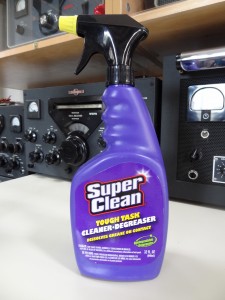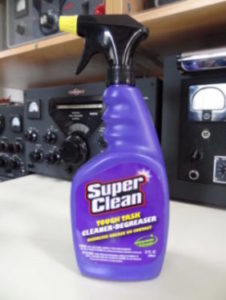by Thomas Bonomo, K6AD —

I’d like to share with you my “secret weapon” for radio chassis cleaning. The dirtier the chassis, the better. Like many restorers, I’m not a fan of the “dishwasher method”, so I used to clean chassis the hard way: rubbing with a rag, a Q-Tip, or a soft brush dampened with some cleaning product. The results were usually only marginally satisfactory. Even using brushes, I was often unable to remove the accumulated crud from tight areas. The chassis looked noticeably better, but never like new, and there was always the risk of ending up with that dreaded “rubbed” look.
I have seen many, many chassis permanently marred by an eager restorer who supplants an inadequate cleaner with generous amounts of elbow grease, leaving behind swirls and a “rubbed” look. Fellow collectors have suggested many cleaners, and I’ve tried them all: Simple Green, 409, Windex, ammonia, etc. etc. These cleaners work to varying degrees, depending on the type of dirt to be removed.
There is, however, another type of cleaner from the automotive field that I’ve found to be far more effective. This product, made by Castrol, is called “Super Clean” and it is based upon a new chemistry in cleaners. This stuff instantly solubilizes oil, grease, and dirt and, most importantly, brown nicotine. This cleaner is not just another soap-based cleaner, yet is biodegradable and phosphate-free.
Here is the best way to use Super Clean, along with a few cautions. First remove all the tubes, then spray the chassis with Super Clean. Avoid getting any liquid into IF cans or transformers, or onto dial scales and painted surfaces. The idea is to get the cleaner only on the chassis. Within seconds, rivers of dirt and nicotine will begin to run off–even from around tube sockets, screws, and rivets that would otherwise require rubbing and brushing. Use a small brush to quickly and lightly go over all surfaces to loosen thicker accumulations of crud. After no more than one minute, rinse the chassis thoroughly with water (avoid getting water in the IF cans and transformers) and let the chassis dry for several days before applying power.
A few words of caution. Super Clean is strong stuff. First, dilute the off-the-shelf product 50% with water. A 50% solution is strong enough to produce the result you want. Second, keep it away from painted surfaces (like the front panel) except for short periods. You don’t want streaking. Third, do not leave it on the chassis for more than one minute. If you must contend with painted surfaces or silk-screened tube designations on the chassis, test a hidden painted spot before proceeding. Some paints are hardier than others. Following these guidelines, I have never had a problem, and I’ve probably cleaned at least eighty radios.
To help protect the chassis from tarnishing and corrosion after it has been cleaned, spray on a thin coat of silicone. Use water-based silicone (often referred to as food-grade silicone) rather than a petroleum-based product, which can attack rubber and some plastics. A commonly available water-based silicone is LPS Heavy-Duty Silicone Lubricant.
If a chassis is not permanently rusted or tarnished, this cleaning technique can often make a brown, nicotine-coated chassis shine like new. Collectors have looked in amazement at some of my “Super Cleaned” Collins amateur radios, thinking that they were new. Corrosion has never been a problem with this cleaner, either. Just flush the chassis well with water. Radios I cleaned back in 1996, including a Collins KW-1 transmitter, still work like a charm. Try this experiment yourself: clean a chassis with Simple Green, and then watch the rivers of brown flowing off the chassis during a subsequent Super Clean treatment. You’ll be amazed. Super Clean is available at most automotive stores and chains like Wal Mart. Simple Green and my other cleaners have now been relegated to more mundane tasks such as cleaning floors and toilets.



Hi Friends,
Very good site with loads of great information. Going to clean some chassis up again for sure. I am a member of the Pittsburgh Antique Radio Society and have many sets in the home. Thanks for your added info and happy collecting…
Roy Johnson KB3FAH
To K6AD; Thanks for the ‘Super Clean” info. Am working on my first refurb, an old Hallicrafters S-20R (basket case). I tried the Super Clean with mixed results. Much of the chassis has what looks like corrosion visible after a trial on half the chassis. Do you reccomend rubbing lightly with something like ScotchBrite to improve removal of corrosion, etc. Much of the half chassis came out looking great from the first trial in areas somewhat protected from the elements.
Thanks for any advice.
Don Richardson, W1COG
Super Clean will not remove corrosion where the metal surface is damaged or oxidized or rusted. Super Clean is only useful for cleaning accumulated crud off the chassis. Works a whole lot better than Simple Green. Super Clean works great for accumulated brown nicotine and will restore a great shine to an uncorroded surface.
Thank you, K6AD, for this information! I am a new ham who has been blessed with finding a Collins station in need of some restoration (new tubes/caps), along with a bit of cleaning. When you say “rinse the chassis thoroughly with water” my heart skips a beat! How in the world do you do this without getting water into the IF cans or transformers?
Thanks for any help you might provide this nervous newbie!
Larry Wilkes, K0SDG
Hahaha, that was exactly my response. But I spoke to enough guys to learn this cleaning method works. I’m very careful when spraying on the cleaner, and I test it first on paint and silkscreened surfaces. When I rinse, I don’t spray it but use a low volume amount from the end of a hose and let it run off one side. Make sure the radio dries in a warm space for many days before you apply power. Note that this cleaner works great on accumulated grime and nicotine, but it won’t remove actual corrosion.
I usually use Windex, but as noted, not that good a result. I’ll try this method next time since I have a bunch of it for my engine work.
Thanks,
Tom
I’m restoring a swan power amp. I’m curious as to how many components are left on the chassis? Variable caps, resistors, coils, misc caps, relays all kept in place?
Thanks Ralph
W4RHD
I try to keep it out of IF cans and any coils that can’t be thoroughly rinsed. I still have radios that I did back in 1995 and they still work great, so no corrosion worries. Beware that it can soften poor paint, so keep the application and rinse short. There is never any need to scrub. Tom
I am commenting on this more than a decade after the publication of this, but it is because I am trying to save some people some serious issues.
So, this caution to anyone reading this super old thread – when it comes to using this product. Besides the warnings posted in the article
DO NOT DO NOT DO NOT allow any of it to leak into the internals of any carbon-track style potentiometer like those built by the ALL popular potentiometer manufacturers of the 1940’s – present. That means Centralab, CTS, Mallory, etc.
This particular cleaner will absolutely and immediately dissolve the bonding agent that holds the carbon track material onto the phenolic board inside the potentiometer. Dissolving this bonding agent immediately and irrevocably lifts the carbon track and thereby absolutely destroys the potentiometer. The carbon is gone, forever.
I AM NOT GUESSING ABOUT THIS…o.k?
Other than that, these kinds of cleaners are great.